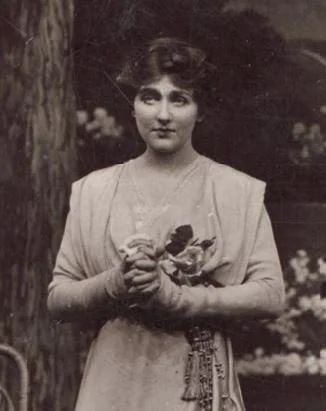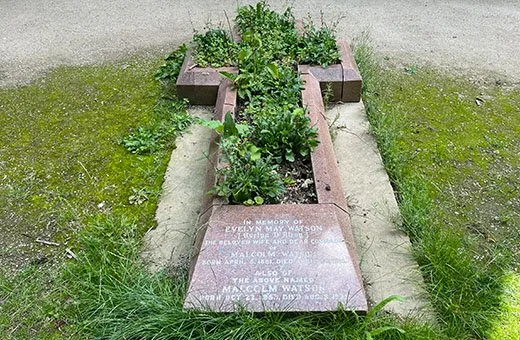Evelyn May Watson (Evelyn D'Alroy)
Buried: 04.05.1915, aged 34
Plot no: RN 14665 | Section: H06
Evelyn May Tegg was born in Stamford Hill on 5 April 1881. Her father, William, was a veterinary surgeon. Evelyn May was the second of three children. William died at the tragically early age of 40, leaving little behind to support his wife and family. Evelyn’s mother, Emily, took in boarders, and also taught music.
Evelyn benefited from her mother’s tuition, and became an accomplished singer and violinist. In 1896 aged just 15, Evelyn had made what was possibly her debut as an actress, in a charity performance of Sidney Grundy’s comedy, A Pair of Spectacles, put on at the Manor Theatre in aid of the North Eastern Hospital for Children, Hackney Road.
The review was of the usual standard for the local press of the time: it was a charity performance, every player is mentioned and we are even told that The furniture for the occasion was kindly lent by Mr Frederick Helliar of 528 Kingsland Road, the lamp being supplied by Mr Salisbury of Dalston Lane. Evelyn gets a mention towards the end of the credits . The names (but not the roles) of five further actors are mentioned, before crediting the band (Mr G R Baker’s well-known orchestra) and finally, the furniture.
The Middlesex Gazette reviewed her performance at a musical event held at Edmonton Town Hall in 1899: she played two delightful violin solos, while her mother, Madam Martin Tegg sang with fine effect ‘The Moorish Maid,’ and ‘Lovely Spring’.”
Evelyn D’Alroy, date unknown. Image: Katchuri, CC BY-SA 4.0
Evelyn was not yet 18 but was appearing under her professional name, Evelyn D’Alroy, in a touring production of The Streets of London. The theatrical agent William Greet signed Evelyn to his Number 1 Touring Company. This was the heyday of touring theatre: the cinema was still in its infancy, but live productions put on by professional companies were eagerly welcomed when they arrived in town with one or sometimes two plays which would run for 6 nights plus a Saturday matinee. When Evelyn joined them, the Greet company were touring solely with Wilson Barrett’s hugely popular play The Sign of the Cross.
In Stockport the local paper’s preview of what the audience could expect gave an indication of just how lavish the production was: Mr William Greet’s No. 1 Company comprises 60 performers in all. Evelyn D’Alroy was noted as a “charming, sympathetic actress".
From the newspaper records it is possible to follow Evelyn’s career broadly up to the early years of the 20th century. She worked not only for William Greet’s company but also with his brother and fellow theatrical agent Ben Greet, which ensured a steady flow of work and kept her in the public eye.
Sources suggest that Evelyn met her future husband, Malcolm Watson when he saw her perform in a production of his play A Man and Two Maids at the Opera House, Northampton, ‘ in 1905’. Details of this play are sadly lacking in the archives, but she can be found in October of that year, displaying her not inconsiderable talents as a musical actress with a fine soprano voice at the Theatre Royal Bradford.
Evelyn D’Alroy and Malcolm Watson – journalist and theatre critic of The Daily Telegraph - began a partnership which was both professional and personal. He was certainly well-placed to support and assist Evelyn’s progress in her stage career. When they married in 1908 Evelyn was 27 and Malcolm 54. The wedding took place at a parish church in Twickenham. This is where Evelyn would return between touring engagements, and from where she now moved on to the next stage of her life, based in London with her husband Malcolm.
By the end of 1908 Evelyn had joined manager Lewis Waller as a leading lady, on tour and at London’s Lyric Theatre. Waller was a popular ‘leading man’ of the contemporary stage.
Evelyn was next recruited by Sir Herbert Beerbohm Tree, at His Majesty’s Theatre. Tree was an actor manager of the Victorian era. Although his style was seen by some as outdated in this new century, his mark of approval could be taken as an indication of a potential star in the making. At His Majesty’s, Evelyn took on roles in Somerset Maugham’s The Explorer and The Fires of Fate, by Arthur Conan Doyle. Evelyn was recalled by one reviewer as “an actress who perhaps approached more nearly to the beauty of the fairy princess of our childhood’s dreams than anyone else. Tall, slender, with golden hair, fine blue eyes, and a very sweet voice, she had a charming personality which will be greatly missed on the stage.”
Photos in the press are grainy and blurred, but studio portraits made in 1910 and 1913, are beautifully posed and lit, and appear strikingly modern. There are several in the National Portrait Gallery’s collection which show her in character for a production at the St James Theatre.
Evelyn returned to the touring circuit with Lewis Waller’s players from 1914 to 1915. In April 1915 the company were in residence at the Theatre Royal Bradford for a week before moving on to the Lyceum, Sheffield where they offered two productions – The Three Musketeers and Monsieur Beaucaire, by Booth Tarkington.
On Friday 23rd April Evelyn was taken ill with appendicitis. She underwent surgery but died some days later. Her death was reported in many of the national papers, as well as in Sheffield and other provincial cities where she had appeared on stage. There were tributes in The Tatler and the Illustrated Sporting and Dramatic News. There were also many obituaries and tributes in the national and provincial press.
The grave of Evelyn and Malcom Watson.
Her obituary in The Stage gave an exhaustive list of Evelyn’s roles during her short but active life. It also gives a fuller account of her final days:
”Her death occurred on Thursday last at a nursing home in Sheffield, following an operation for appendicitis. She had been seized with illness while acting with Mr Lewis Waller’s company at the Royal. At the end of February there had been a first operation, and apparently Miss D’Alroy’s recovery had not been so complete as had been supposed.…..
The funeral took place on Tuesday in Abney Park Cemetery. There was a very large gathering of members of the theatrical profession, as well as of private friends.
The floral tributes completely covered the hearse conveying the coffin, as well as four open landaus which headed the cortége from Ridgmount Gardens [the Watson’s Bloomsbury home] to the cemetery.”
“Among the anonymous tributes mention should be made of a cluster of roses accompanied by the simple inscription, “From Just a Chorus Girl.”
How this grave, with a cruciform kerb of red granite with a sloping engraved foot stone, orientated east-west, came to be sited so near the Chapel is unknown. Research of the records at Hackney Archives has not revealed any definitive information, apart from the undertakers name and that of Underwood and Son, the stonemasons. Further investigation is to follow.


